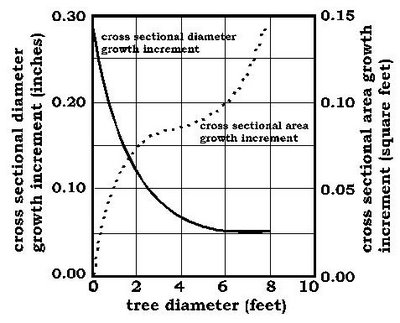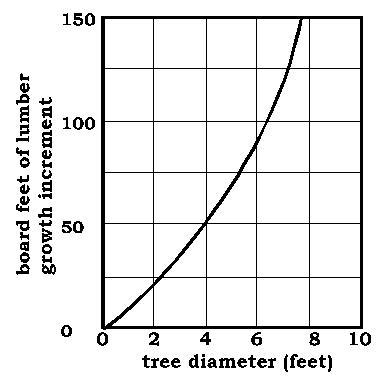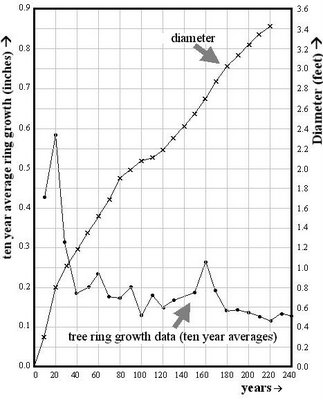Lumber Production
Incontrovertible Indicator of the Health of our Environment
In the late eighties and early nineties the spotted owl controversy became heated in the Pacific Northwest. Loggers complained that environmentalists preferred an obscure bird which virtually no one had ever seen to letting ambitious men perform real work for a living for their families. Environmentalists ineptly argued that the spotted owl was only an indicator species of what was happening to our environment.
The logging industry began a public relations campaign whose radio and television adds ran something like this, "Weyerhauser is dedicated to effectively managing our forests. We harvest just two percent of the forest per year, etc.." Two percent harvest per year means a tree in Weyerhauser country can expect to live fifty years. So as I drive through regions of clear cut devastation and read the prominent signs that are posted for sightseers stating: "This forest was replanted by Weyerhauser in 1985." I began to calibrate what it all meant. Driving up highway 410 past Enumclaw, there was a new sign I had never seen before, "Weyerhauser, replanted in 1949." Oh, oh, I knew some trees a foot to a foot-and-a-half through for whom the grim reaper yearned! He shortly reaped!
Why a fifty year life cycle for a tree? I grew up walking the woods, hunting, daydreaming - mostly by myself. I remember the major stumps deep in the Skagit County forest, easily ten feet across, obviously sawed off ten or fifteen feet above the ground sacrificing thousands of board feet to the convenience of a clean fall. There was always that wonder, what was it like back then when trees were not 1½ to 2 feet through, but ten feet? It was like walking among dinosaur bones. These will mostly have perished now with another 40 or 50 years of decay. But I remember many places up the Skagit river around Marble Mount where ten foot Douglas fir were still standing proudly right near the road.
Not any more! In 1992 I took the trip around the Olympic peninsula - up through Forks - to see for myself what the situation looked like over there. You would not have believed it! There were so few trees left that you would laugh if it weren't so sad. All this talk about employment for the impoverished of Forks and we're talking the possibility of keeping them employed a couple more years at most even if we are willing to donate our last memories of a big tree. The audacity of it all. A sign read "Olympic National Rain Forest" with an arrow off to the right; you look that way and all you see for miles are stumps protruding a foot and a half above dirt like Ozymandias! Thousands and thousands of acres of it, right to the pavement - no row of trees to hide the devastation from nature lovers - no apology such as this ten thousand acre tract was destroyed to feed the boys and girls of Forks.
Trees as Lumber Manufacturing Plants
If lumber production is the objective, harvesting a fifty year old tree is idiotic. It has very little to do with the supposed impracticalities of tree-hugging liberals or perceived evils of ecofascists that would address the extinction of the spotted owl or sockeye salmon or others of the many species that man is crowding out of existence each day. It has more to do with the bottom line which hardwood thumpers of board rooms around this wobbling planet understand. A tree is not just the lumber of which it is comprised, but a lumber manufacturing plant of amazing efficiency whose productivity increases phenomenally with age. If you harvest trees after fifty years, you're going to lose a lot of money over the long haul, not in law suits or advertising, but in the number of board feet produced by the same forests each year - a difference so profound that only near-sighted selfishness could not succumb to the argument. It's like pulling all the beets for beet greens; it misses the point.
In searching the Internet for data on conifer forest growth, I came upon some sites with research data on conifer growth for various species, harvesting methods, etc.. One was the home page of a forestry department member at the University of Washington. It included some bonafide conifer growth formulas. I contacted him for details.
Since the formulas result from regression analyses, they apply more or less exclusively to the data from which they were obtained. That data does, however, include 1700 Douglas fir from many Pacific forest stands including trees with diameters of as much as seven feet and heights of nearly 300 feet -trees that are hundreds of years old. In the first of the figures below I have shown the resulting cross sectional diameter increment (in inches) and I've also shown that although the diameter growth slows with the size (age) of the tree, the cross sectional area is a monotonically increasing function.
I have taken a constant value of 50 for the height-to-diameter ratio. (It does not seem to vary widely within a species.) In the second figure the resulting height data has been combined with the cross sectional area increment to produce an annual increase in number of board feet of lumber produced by the tree. This function is a steep nonlinear function of tree size. How much more lumber it produces this year than it did last year increases dramatically each year. Naturally there are other issues including forest composition with increasing average age of trees but decreases in density imposed by systematic thinning would not overshadow this increase.
Data support the notion of a tree as a lumber producing factory that gets better and better each year that it lives. A tree's monetary value increases highly nonlinearly. Unless the tree is diseased or seriously damaged by storms, its lumber is better quality each year and there is much more of it. So the best forest management policy would seem to be to thin to maintain the rapid growth of giants, salvage them when they are damaged by storms or stricken with disease and let them continue to improve their process till then. Who would cash in a stock with such a bright economic future?
Revisiting Remarks on Logging
Old growth forests alas are all but gone so I was not speaking primarily of them. I understand the argument of those who would point out that the spotted owl controversy pertained exclusively to such old growth forests that will probably never be again. The "spotted owl argument" was "inept" not because it was not scientifically based although I have included here a photo of a spotted owl rescured by the author in a major metropolitan area showing that the species continues to survive. (We have seen him again as recently as October 2006.) But what was inept about that argument was that it was not geared to the minds of those who needed to be persuaded. It fueled a debate between fiscal economic values and more nebulous environmental benefits to which business men are less and less sympathetic. I despise this trend just as others hopefully do as well, but when arguing with such business mentalities it is misdirected to argue esthetics, ethics, whatever, when there are overwhelming economic reasons on one's side of the argument on which one can rely. If the public had understood that they were not making the return on their investment that conscionable management would give them, they might have been much less sympathetic to the near term timber industry interests in fleecing public lands. Perhaps timber interests could have been persuaded by the arguments as well.
Of course, we're not speaking primarily of private land which may be the concern of some, although I'm not sure from whence "private" property rights are assumed to have sprung. We're talking about predominantly public land we all own under the partnership of democratic government and how best to use it. There are sixty million people in America who buy bird seed for their window sills, decks and verandahs; it is estimated that "about one third of North Americans have at least some interest in watching birds." Not everyone who loves a diversity of life is a "zany masochist"as some would suggest. Greed and paranoia are typically more indicative of unhealthy states of mind than kindness and perspective.
I spent a pleasant Labor Day week-end with my family on Lake Quinault which is West of the Olympic mountain range in Washington State - the heart of the temperate rain forest region. I visited the world's largest spruce tree - 58 feet around. I also saw many huge firs - one I measured was 28 feet two inches around at breast height and it was no more special that fifty or a hundred others along that short section of the trail. I measured rings on a spruce that had fallen across the trail and had had to be sawed in two for passage. Sixty feet from its base it had 250 growth rings and was three feet in diameter. The diameter increment curve I showed in the previous article for Douglas fir trees was an underestimate of the ability of a tree to continue its diameter increment which in this case went down to about 0.20 inch within 40 years and remained at approximately the same level for the next two hundred years. (See the figure below.) This tree was not large in comparison to others on the hike. It had blown over in a recent storm; there was no sign of its having been rotted anywhere. Unfortunately this hike is a short four mile loop and from across the lake where we stayed it was obvious that the entire loop was in a very small preserve (relative to the size of the hill at the lower reaches of which it stood) - a mere token for tourists. Visible above it from across the lake (although not from the trail) was a large slide area caused by earlier deforestation of the hillside. A sign of poor management.
Driving on up from Quinault over to and along the beautiful Washington Coastline, there are many hundreds of square miles of devastation where stumps and debris - scattered as if defiantly - mock us, the owners of the missing temperate rain forests. It's better than in 1992 only because many of the clear-cut areas now have replants standing ten to fifteen feet in height so one can no longer see the tremendous scope of the devastation.
My article addressed the logging industry - not the tourist industry - its future, not its past! When one sees logging trucks in the Northwest, they are carrying logs whose diameters place them in the fifty year age bracket; you don't see caravans of trucks with one huge log on them as one did quite often in the days of my youth. These new growth forests that I'm talking about have been planted for 50 year harvests so they would need (or could use) thinning at fifty years and at intervals thereafter using the logging roads that already exist which are not unlike the trail through the old growth preserve that I spoke of above. These roads are big enough for a truck and a cat (caterpillar tractor) and a muleskinner which would come through only occasionally to pick up the logs which had been trimmed after having met with natural disaster like the one I measured and illustrated in the figure above. (Hurricane level storms occur in the Northwest about every 20 years.) And the point is that such forests would be beautiful and economical such that we could take pride in ownership of our land again! Clearly since these trees can live easily a thousand years, the old growth characteristic would not be realized till well along in this third millennium AD, but they would soon begin to exhibit many of those features - probably even being hospitable to the spotted owl. And, they would become more economical, more ecologically sound and more beautiful with every passing year.
As an aside, it is indeed unfortunate that large conifers must now have names, thanks to their rarity - a situation for which forest management practices are responsible! The "General Sherman"sequoia in California contains 600,000 board feet of lumber and continues to produce the equivalent of a one foot diameter tree in lumber every year; this is after having survived a couple of millennia.
|

















1 comment:
a particular industry or a particular species. which is more important?
conservation or production. which is more important?
Post a Comment